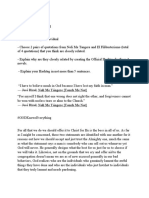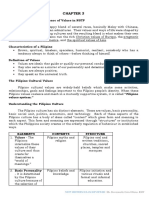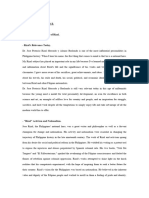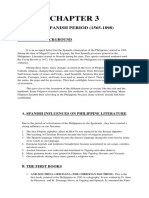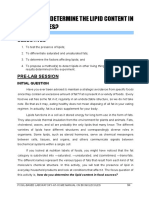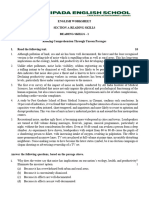Filipino Cultural Interview Paper
Filipino Cultural Interview Paper
Uploaded by
api-285132682Copyright:
Available Formats
Filipino Cultural Interview Paper
Filipino Cultural Interview Paper
Uploaded by
api-285132682Original Title
Copyright
Available Formats
Share this document
Did you find this document useful?
Is this content inappropriate?
Copyright:
Available Formats
Filipino Cultural Interview Paper
Filipino Cultural Interview Paper
Uploaded by
api-285132682Copyright:
Available Formats
Running head: FILIPINO CULTURAL INTERVIEW
Exploring the Cultural Perspective of Filipinos
Nikki Thao
California State University, Stanislaus
FILIPINO CULTURAL INTERVIEW
Exploring the Cultural Perspective of Filipinos
Mark Anthony Bartholome Corpuz is a twenty- one year old, Filipino male that I have
known since my second year of high school. Having known him for so long, I feel that I have
little knowledge about his culture and beliefs. Therefore, this cultural interview was a great
opportunity for me to learn about the cultural views and practices of the Filipino culture. The
interview took place on October 12, 2013. Since Mark attends California Polytechnic State
University San Luis Obispo, the communication was through a phone interview, followed by
emails with questions that needed clarification. Marks responses will cover the cultural values,
beliefs, and religious aspects of the Filipino culture; which will also integrate Larry Purnells
(2002) twelve domains of cultural competence, including overview/ heritage, communication,
family roles and organization, workforce issues, biocultural ecology, high risk behaviors,
nutrition, pregnancy and childbearing practices, death rituals, spirituality, health- care practices,
and health- care practitioners.
Overview/ Heritage
The origins of the Filipinos began off the coast of Asia, in the Philippines (M. A. B.
Corpuz, personal communication, October, 12, 2013). In this geographical area, the climate is
humid and hot, with lots of islands in the vicinity. The lands of the Philippines are completely
surrounded in a tropical zone, where vast mountain ranges can be seen, along with beautiful
scenery of various small islands. From as early as the 14th century, the arrival of the first
Filipinos to the United States was one of the longest based in immigration history (David &
Nadal, 2013). The first Filipinos were slaves that had boarded Spanish ships and were the first
Asians to settle in the United States after escaping from servitude. One of the biggest challenges
that many Filipinos faced in the Philippines was long colonization of this culture by the Spanish
and then the Americans (Davis & Nadal, 2013). Many Filipinos experienced some kind of
FILIPINO CULTURAL INTERVIEW
cultural shock, as they were forced to give up their culture and learn the ways of the Spanish and
American culture. This can be evident today with English being the primary language used by
school institutions in the Philippines. Other evidence includes the majority of Filipino
descendants taking on names that come from Spanish roots (M. A. B. Corpuz, personal
communication, October 12, 2013).
Mark A. B. Corpuz (2013) voices that the major motivation for his family to immigrate
to the United States was to live a better life, away from all the trials and tribulations of harder
work done in the Philippines (M. A. B. Corpuz, personal communication, October 12, 2013).
His family believed that there would supposedly be an easier life in America and chose to
immigrate. With the economic hardships that his culture has faced while adjusting to life in
America, Mark noted that this cultural group tries to do their best for a better life across the
seas.
To the Filipino culture, education is highly important. Coming from an Asian/ Pacific
background, many Filipino families believe that a good education indicates a better life. Many of
the elders in the culture also believe that as a family member obtains a higher education, they in
retrospect are bringing honor and respect to the family. Coming from another country, many
older generation adults believe that there are more chances for their children to obtain a good
life, as the parents could not get the education while living in the Philippines. Predominately
when coming to the United States, many Filipinos took on jobs that they could get a hold of after
immigrating. Mark noted that for his parents, such jobs included picking fruits and working in
the fields. Today, many individuals of Filipino descent are predominately working in the medical
field, with a majority of individuals getting their nursing degree in the Philippines and finding
jobs in the United States (M. A. B. Corpuz, personal communication, October 12, 2013).
Communication
FILIPINO CULTURAL INTERVIEW
In terms of the dominant language, most Filipinos speak Tagalog, whereas common
dialects in the Philippines consisted of Ilocano and Visayan. Filipinos have a loud, joyful voice,
with a sense of humor, as this culture tends to be very outgoing. Many Filipinos are more willing
to share their thoughts and views of their personal experiences than other cultures. Mark (2013)
explains that his parents take the time to share their personal life stories, in which they can teach
or disclose a part of their personal experiences living a hard life in America. In the Filipino
society, people greet each other generously. Girls are more likely to give hugs each other and
their counterparts. Filipino men would use a handshake as a symbol of greeting and often times
they would hug a younger female if they are closely related. As a sign of respect and appreciation
for an elder that they look up to, an individual would usually bless that person by taking their
hand and lifting it towards that individuals head. Regarding personal space, many Filipinos like
to stay close to each other. If a person distances themselves from the person who is talking, this
can be seen as a form of disrespect.
With nonverbal communications such as eye contact, many Filipinos view eye contact as
a sign of respect and it is another way of saying hello to someone. Mark (2013) indicates that
among Filipinos, facial expressions are the first thing to be notice in the culture. Whenever a
person put on a long face, this usually specifies that something is wrong. Emotions among
Filipinos are not usually openly expressed. A Filipinos pride sometimes stops them from
showing too much emotion (M. A. B. Corpuz, personal communication, October 12, 2013).
Mark notes that his family is more oriented towards the future, as his parents choose to spend
their time making sure that he and his sister are growing up properly. Among Filipinos, names
have a special meaning. Mark Anthony is referred to as a double name that represents people
from the Bible. Bartolome is the middle name, which came from his mothers maiden name.
Corpuz is his fathers last name.
FILIPINO CULTURAL INTERVIEW
Family Roles and Organization
In a typical Filipino family, the head of the household is usually the oldest male (M.A. B.
Corpuz, personal communication, October 12, 2013). In Marks case, his father is the main
authoritative figure that upholds the rules in the household. As Mark and his older sister grew up,
their father was more lenient on them because of the fact that they were beginning to learn more
about the world and becoming independent. In the Filipino culture, children and babies are
extremely important, as they are seen as an amazing accomplishment to carry on the family
name. When the children become adolescents, emphasis on drugs, pregnancy, and sex education
is taught.
Within the Filipino culture, extended families are a major contribution. Mark (2013)
emphasizes that in his family, an essential goal to remember is that families stay together,
through thick or thin, no matter the situation. Family is highly valued in the Filipino culture
because everyone is very closed knitted. Gender roles among the men and women in Marks
family are fairly divided as both genders could work to provide for the family; in addition to that
the woman also takes care of the children. Everyone in the family is expected to do house chores,
no matter what gender they are. The oldest of the family members is usually the one who is
highly respected because they are the one with the most wisdom and knowledge. Filipinos prefer
to have a traditional family, but Mark explains that his family has no resentment towards blended
families and/ or single parent homes.
Workforce Issues
In the workforce, many older Filipino adults experience a hard time holding onto a proper
job, due to the lack of higher education in the Philippines. Mark notes that when his family
immigrated to the United States, his parents had a hard time finding permanent jobs, and where
often working in the fields and picking fruits. However, among most Asian cultures, Filipinos
FILIPINO CULTURAL INTERVIEW
were more likely to find jobs because many Filipinos learned to speak the dominant English
language at a younger age. This domain is not adequately covered because Mark (2013) notes
that he has limited knowledge on the type of experiences that Filipinos face in the workforce. In
fact, Mark has never held a job before, therefore, he cannot relate to this domain.
Biocultural Ecology
In the Filipino culture, skin coloration and physical appearance varies. With skin tone,
many Filipinos can have a darker to medium- fair skin color. Depending on what parts of the
Philippines that individual comes from, their skin color may appear darker or lighter. In regards
to physical appearances, many Filipinos prefer the fuller, curvy figures. Women are not expected
to have a slim, tall figure, as a majority of Asian women are more petite. The Filipino men tend
to be of medium built.
Some of the common conditions that can be identified with the Filipino culture include
high blood pressure and diabetes. Among the second largest group of immigrants who live in the
United States, Filipinos are at a higher risk of developing type II diabetes, due to an increase in
obesity (Leake et al., 2012). Studies show that among the women who are tested for diabetes in
the San Diego County, one in three Filipino women were more likely to have diabetes than one
in eleven Caucasian women. While obesity may be one the leading factors towards developing
diabetes, a study from Hawaii shows that Filipino- Americans had the highest chance rate of
metabolic syndrome, especially among those who have a lower body mass index. Those
individuals who have the metabolic syndrome would be at risk for having impaired fasting
glucose, which would increase their chances of developing type II diabetes (Leake et. Al, 2012).
High Risk Behaviors
Potential high risk behaviors that can be seen in the Filipino culture include occasional
alcohol consumption, with a large number of elderly- Filipino men who smoke cigarettes (M. A.
FILIPINO CULTURAL INTERVIEW
B. Corpuz, personal communication, October 12, 2013). Physical activity among individuals in
the culture varies. Younger individuals are more active, while older adults tend to stay home and
do occasional walks around the neighborhood. Considering safety measures within the cultures,
Filipinos are more careful and alert. For example, seat belts and bike helmets some of the
measures used.
Nutrition
In the Filipino culture, one common food that is often found with a meal is rice. Among
many Asian cultures, rice is the essential cuisine, as it can be eaten with other varieties of dishes.
A meal isnt a meal without rice (M. A. B. Corpuz, personal communication, October 12,
2013). Major ingredients that are commonly used by Filipinos include salt, black pepper,
monosodium glutamate (MSG), garlic, and onions. Meats that are used include beef, pork,
chicken, and goat. Traditional vegetables that are sometimes used include lemon grass,
eggplants, and squash. There are no limitations to what Filipinos are not allowed to eat, but on
occasion, Mark (2013) would avoid eating a certain meat for a week, due to religious reasons.
His family also expresses the importance of eating hot food. The reason is because hot foods are
supposed to cleanse the body of any illnesses, whereas cold food is less effective.
Pregnancy and Childbearing Practices
Among Filipinos, a view on pregnancy that is highly enforced is that a person should not
get pregnant before they are married (M.A. B. Corpuz, personal communication, October 12,
2013). The views of pregnancy and childbearing practices are not highly expressed and share
with male family members of the Filipino culture. In other words, this domain is not adequately
covered because as a male in the family, Mark A. Corpuz has limited knowledge about the birth
process. Usually females of the Filipino culture are more informed about the practices that relate
to childbearing, whether it is taboo, restrictions, and cultural views.
FILIPINO CULTURAL INTERVIEW
8
Death Rituals
All cultures share core similarities (Purnell, 2002), but among the diverse cultural
groups, death rituals that are practiced varies. In the Filipino culture, respect is highly valued, as
family members gather to say their goodbyes to the deceased (M.A. B. Corpuz, personal
communication, October 12, 2013). Within the Filipino culture, there is a mixture of modern, as
most Filipinos are Catholics, and traditional practices. The culture usually has ten days of prayer
after the death of a family member. A funeral session is then held for the deceased, which is
usually done at a funeral home; where the casket is displayed openly or closed. With the death of
a close one, close family members will express grief and sadness; therefore it is important that as
a guest, proper manners should be used. Friends and families gather to pay their respects to the
decease and during this time, formal meals are prepared for the guests and relatives. Donations
can be made to the family, in order to cover the cost of the funeral. At the end of the funeral,
close family members usually carried the close casket and the deceased is buried in the cemetery
of the familys choice. Forty days after the burial of the deceased, relatives come together at the
familys home and do another day of prayer. The reason why Filipinos have practice their death
rituals this way is because they believe this ensures that the deceased family member will have
a faster entry into heaven (M.A. B. Corpuz, personal communication, October 12, 2013).
Spirituality
Spirituality can be defined as an entity that embodies the overall care of an individual,
which revolves around a divine connection between life and creation (De Guzman et al., 2009).
In other words, the individual experiences some kind of inner connection that allows them to let
go of their fears and embody a sense of peace. The concept of spirituality is closely related to
religion, thus the type of spiritual care that an individual may seek is highly a reflection of their
religion. In the Filipino culture, a majority of individuals are Catholics (M.A. B. Corpuz,
FILIPINO CULTURAL INTERVIEW
personal communication, October 12, 2013). The belief of God holds a strong value for this
cultural group because God represents the divine being that will guide the people. The use of
prayers that is practiced within this culture is a way of being one with God, thus carrying out that
faith, God will protect them. According to De Guzman et al. (2009), elderly patients of Filipino
origins believe that by praying, reading the Bible, and listening to sermons, they are
reestablishing a stronger bond with God. Life to the Filipino culture means living to the fullest,
no matter what trials lies ahead. Mark (2013) emphasizes that goods sources to rely on include
ones own family and friends.
Health- care Practices
Many Filipinos rely on doctors when it comes to preventive care and health practices (M.
A. B. Corpuz, personal communication, October 12, 2013). Sometimes, older family members
are more likely to use traditional medicine to treat an illness, but many individuals rely on
modern medicine. Mark (2013) notes that in the Filipino culture, over- the- counter medications
are used often because it helps people go about their day and live their lives. Family is an
important aspect of the Filipino culture because if a family member becomes chronically ill,
everyone else in the family is affected. Mental illness has a huge impact on many people. As a
family- oriented culture, Filipinos deal with the illness seriously if it is in the family or among
friends. Sometimes it is hard to comprehend that a loved one is sick, but families try to deal with
the illness as much as they can.
Health-care Practitioners
Health- care practitioners are more likely to be accepted among many people of the
Filipino culture. In fact, a large number of Filipinos work in the medical field, especially as
nurses, and are more likely to acknowledge modern medicine and practice. Mark (2013)
emphasizes that whenever a family member is seriously ill; his family relied on a health- care
FILIPINO CULTURAL INTERVIEW
10
practitioner to provide the specific needs for that individual. To him, there is no preference to
whether the practitioner is a male or female doctor.
Three Cultural Interventions/ One Standard of Practice
In order to facilitate the appropriate cultural care for patient interventions, Madeleine
Leiningers three modes of cultural care are addressed (Mixer, 2011). Preservation or
maintenance incorporates the idea that the patients culture is maintained, as long as there is no
effect on patients wellbeing. Accommodation or negotiation refers to the idea of finding a
common ground between patient and the nurses view, where there is a win-win situation.
Repatterning or restructuring refers to the idea of changing the patients lifestyle, while
respecting their beliefs and improving patients well- being (Mixer, 2011).
If Mark A. B. Corpuz was in acute care, one important consideration is the type of
nutrition he is receiving. Mark is Filipino and his culture stresses the importance of eating hot
foods because it is supposed to cleanse the body. Therefore, as an intervention, I would avoid
giving my patient cold food and ice water. In the Filipino culture, prayers have a special
meaning, as most individuals are Catholics and have faith in God. By allowing the patient to
have small prayer sessions with his family, this will greatly improve his health because there is
no physical harm done. Another important thing to consider is family- centered care. Family is a
strong support for the patient, so it is important to involve the patients family in his care. By
allowing the patients family to take part, both sides would be more relax and happy. By
acknowledging Marks preference for hot foods, allowing prayer sessions, and incorporating a
family- centered care, Leiningers mode of cultural care preservation is used as the patients
cultural values and beliefs are retained.
One Standard of Practice that I thought was closely related to this cultural interview was
Standard 3: Knowledge of Cultures (Douglas et al., 2011). As nurses, gaining a clearer
FILIPINO CULTURAL INTERVIEW
11
understanding of a patients cultural and religious beliefs can create a healthier patient care
environment. Taking the time to recognize the patients values and beliefs will generate a bond
between the nurse and patient because there is communication (Douglas et al., 2011). There is a
lot to know about the Filipino culture, but having some knowledge of the cultures overall views
can greatly improve my practice of care for my patient.
Communication Experience
Overall, I think that the communication experience that I had was really good. Learning
about Marks Filipino culture, has made me have more respect for the culture and I believe I
have develop a stronger friendship with Mark. The overall experience has really helped me to
practice with interviewing other people. Personally, I tend to be more on the shy side, so being
able to go out and talk to an individual about their culture has really helped me step up my game.
What worked well with this experience was that I was able to gain more knowledge about a
culture that I made some day encounter in my care of practice. If I could do it differently next
time, I believe I would prefer to have a face- to- face interview. Although a phone interview is
okay, I felt that I did not have a deeper connection with my interviewee. In other words, it would
have been good to do a face- to- face interview because I would have been able to see how my
interviewee reacts to my questions, in terms of facials expressions and tone of voice.
Culture holds an important place among many diverse ethnical groups. In order to
facilitate a better understanding and care for our patients, as nurses, we have to be culturally
sensitive our patients beliefs and values. Mark Anthony Bartholome Corpuz is a great friend and
fellow peer, who have taken his time to make this cultural interview possible. His input provides
a deeper awareness of the cultural values, beliefs and religious aspects of the Filipino culture. In
all, the Filipino culture has taught me that although there are variations among Asian cultures,
the values and beliefs that are practiced by these cultures are similar in one shape or form.
FILIPINO CULTURAL INTERVIEW
12
Reference
David, E. J. R. & Nadal, K. L. (2013). The colonial context of Filipino American immigrants
psychological experiences. Cultural Diversity and Ethnic Minority Psychology, 19(3).
298-309. doi: 10.1037/a0032903
De Guzman, A. B., Dalay, N. J. Z., De Guzman, A. J. M., De Jesus, L. L. E., De
Mesa, J. B. C.,
& Flores, J. D. D. (2009). Spirituality in nursing: Filipino elderlys
concept of, distance
from, and involvement with god. Educational Gerontology, 35, 929-944.
doi: 10.1080/03601270902717962
Douglas, M. J., Pierce, J. U., Rosenkoetter, M., Pacquiao, D., Callister, L. C., Hattar-Pollara, M.,
Purnell, L. (2011). Standards of practice for culturally competent nursing care: 2011
update. Journal of Transcultural Nursing, 22, 317-333. doi: 10.1177/1043659611412965
Leake, A.R., Bermudo, V. C., Jacob, J., Jacob, M. R., Inouye, J. (2012). Health is
wealth:
methods to improve attendance in lifestyle intervention for a largely
immigrant FilipinoAmerican sample. J Immigrant Minority Health. 14. 475-480. doi:
10.1007/s10903-011-9487-0
Mixer, S. (2011). Use of the culture care theory to discover nursing faculty care expressions,
patterns, and practices related to teaching culture care. The Online Journal of Cultural
Competence in Nursing and Healthcare, 1(1), 3-14.
Purnell, L. (2002). The Purnell model of cultural competence. Journal of Transcultural Nursing,
13(3), 193-196. doi: 10.1177/10459602013003006
FILIPINO CULTURAL INTERVIEW
13
You might also like
- Full Strength A Training Handbook For A Strong Back and A Healthy Body PDFDocument215 pagesFull Strength A Training Handbook For A Strong Back and A Healthy Body PDFMajda Bajramović100% (4)
- Case ScenarioDocument2 pagesCase ScenarioMARIA ANGELIKA DEL ROSARIONo ratings yet
- José Rizal, Noli Me Tángere (Touch Me Not)Document2 pagesJosé Rizal, Noli Me Tángere (Touch Me Not)Camille SergioNo ratings yet
- De La Salle Health Sciences InstituteDocument26 pagesDe La Salle Health Sciences InstituteRye DesuNo ratings yet
- Facetime PresentationDocument10 pagesFacetime Presentationapi-484525536No ratings yet
- CBC Housekeeping NC IiDocument62 pagesCBC Housekeeping NC Iiagnes100% (4)
- Hydrocone Manual - S223.360.01.en PDFDocument291 pagesHydrocone Manual - S223.360.01.en PDFLmf Daniel100% (3)
- CLSI Antifungical Susceptibility Test UpdatedDocument34 pagesCLSI Antifungical Susceptibility Test UpdatedSofiaMarmolejoNo ratings yet
- History of Health EducationDocument3 pagesHistory of Health Education3amabelle arevaloNo ratings yet
- The Essence of Values in NSTP: NSTP Midterm Exam ReviewerDocument12 pagesThe Essence of Values in NSTP: NSTP Midterm Exam ReviewerMIKAYLA ELAINE P. DELA CRUZNo ratings yet
- Bioethics CU 1Document1 pageBioethics CU 1ImongheartNo ratings yet
- Reflection Paper. Rizal, Life and WorksDocument5 pagesReflection Paper. Rizal, Life and WorksMichael S. Muli Jr.No ratings yet
- Activity 1 - Life Cycle and Goal Setting - Doc (FrancisMalicdem)Document2 pagesActivity 1 - Life Cycle and Goal Setting - Doc (FrancisMalicdem)Francis MalicdemNo ratings yet
- Spanish Chapter 3Document3 pagesSpanish Chapter 3Gaelle CBNo ratings yet
- Lesson 4 Module Title: Leadership TrainingDocument8 pagesLesson 4 Module Title: Leadership TrainingAnamae Detaro DarucaNo ratings yet
- History of Self-DefenseDocument2 pagesHistory of Self-DefenseReanne Nicole MasangkayNo ratings yet
- Lariosa - 3A - Exile, Trial, and DeathDocument2 pagesLariosa - 3A - Exile, Trial, and DeathAllan Gabriel LariosaNo ratings yet
- CH30Document89 pagesCH30Jan Oliver YaresNo ratings yet
- 2010 TFN Module Unit 06 Nursing Paradigm - NursingDocument43 pages2010 TFN Module Unit 06 Nursing Paradigm - NursingCamille Denise Nucum100% (1)
- BSCE1E - YSIT, ERIKA KYLA - Fact or FakeDocument4 pagesBSCE1E - YSIT, ERIKA KYLA - Fact or FakeErika YsitNo ratings yet
- NCM 103 History of Nursing 2021Document67 pagesNCM 103 History of Nursing 2021Karl TorresNo ratings yet
- Pamantasan NG Cabuyao: College of NursingDocument73 pagesPamantasan NG Cabuyao: College of NursingTrisha SuazoNo ratings yet
- NCM 103 Chapter 36 Skin Integrity and Wound Care (Canvas)Document121 pagesNCM 103 Chapter 36 Skin Integrity and Wound Care (Canvas)AinaB ManaloNo ratings yet
- Elementary Students Being Taught of Sex EducationDocument3 pagesElementary Students Being Taught of Sex EducationAccel FiestadaNo ratings yet
- 2010 - ICN Scope of Nursing and Decision Making Toolkit - EngDocument60 pages2010 - ICN Scope of Nursing and Decision Making Toolkit - EngAshish Marandi100% (1)
- M2L1: Tracing Rizal's Historical Roots - While Task 1Document1 pageM2L1: Tracing Rizal's Historical Roots - While Task 124 PAULINO ALDRIN MUJARNo ratings yet
- Module 14Document5 pagesModule 14camille nina jane navarroNo ratings yet
- Case Scenario 2Document8 pagesCase Scenario 2Minette BucioNo ratings yet
- Ethical Final EssayDocument6 pagesEthical Final EssayTitus KoechNo ratings yet
- Context-Environment To Which Nursing Act Takes Place Content - Subject of Theory Process - Method by Which Nurse Acts in Nursing Theory NursingDocument22 pagesContext-Environment To Which Nursing Act Takes Place Content - Subject of Theory Process - Method by Which Nurse Acts in Nursing Theory NursingShyenNo ratings yet
- List Down 5 Examples of Common Software For Communication Purposes in Each CategoryDocument1 pageList Down 5 Examples of Common Software For Communication Purposes in Each CategoryJunelle Bautista PagalNo ratings yet
- 2 Prelims Florence NightingaleDocument2 pages2 Prelims Florence NightingaleTrisha100% (1)
- CHN Lec 1 5Document7 pagesCHN Lec 1 5Altea PasiaNo ratings yet
- Unit 2 Care of Child .EditedDocument20 pagesUnit 2 Care of Child .EditedGian Delos SantosNo ratings yet
- Greene's Precede Procede ModelDocument4 pagesGreene's Precede Procede ModelBk GonzalesNo ratings yet
- Nationalmuseum DONEDocument20 pagesNationalmuseum DONEExcel BeldaNo ratings yet
- Worksheet Carbohydrate-Related DiseasesDocument3 pagesWorksheet Carbohydrate-Related DiseasesDaniel Angelo ArangoNo ratings yet
- Wcfe Ii 001 PDFDocument15 pagesWcfe Ii 001 PDFAnn Madrigal MauzarNo ratings yet
- Question 3Document1 pageQuestion 3Niño Dwayne TuboNo ratings yet
- Principles of Good Teaching PracticeDocument33 pagesPrinciples of Good Teaching Practiceacey keyleyNo ratings yet
- Family Nursing ProcessDocument4 pagesFamily Nursing ProcessAdri SinclaireNo ratings yet
- Review of The Nursing ProcessDocument2 pagesReview of The Nursing Processmarkkkkkkkheeess100% (1)
- Filipino CulturalDocument25 pagesFilipino CulturalAbegail Flores100% (1)
- Case 1-Clinical Case StudyDocument4 pagesCase 1-Clinical Case StudyRachel VillanuevaNo ratings yet
- PERCY HILL ARTICLE AnalysisDocument1 pagePERCY HILL ARTICLE AnalysisMarwin OditaNo ratings yet
- The Nurse As An EducatorDocument4 pagesThe Nurse As An EducatorAlbean DelojeroNo ratings yet
- GE112 2023 2024 1st Sem ModuleDocument61 pagesGE112 2023 2024 1st Sem ModuleAgri BasketNo ratings yet
- Chapter 15-Reviwer NIDocument3 pagesChapter 15-Reviwer NIAbigail Ann BinalayNo ratings yet
- Experiment 5 - PLAHDocument24 pagesExperiment 5 - PLAHJena CamangegNo ratings yet
- General Survey and Integumentary I. General Appearance and Mental Status Normal Findings Actual Findings Analysis and InterpretationDocument9 pagesGeneral Survey and Integumentary I. General Appearance and Mental Status Normal Findings Actual Findings Analysis and InterpretationAllana RayosNo ratings yet
- II-12BSA Roxas WEEK03 Assignment PDFDocument2 pagesII-12BSA Roxas WEEK03 Assignment PDFJason RecanaNo ratings yet
- The Contemporary WorldDocument8 pagesThe Contemporary WorldKayeDae Dela CruzNo ratings yet
- Imogene King Sec CDocument32 pagesImogene King Sec CDairyl TagaroNo ratings yet
- Primary Sources and Secondary Sources of Acquiring COVID-19 InformationDocument1 pagePrimary Sources and Secondary Sources of Acquiring COVID-19 InformationSareno PJhēaNo ratings yet
- Wallis - Section 2 - Module 1 - "End Virginity Testing" and The "End of Female Genital Mutilation"Document1 pageWallis - Section 2 - Module 1 - "End Virginity Testing" and The "End of Female Genital Mutilation"Martha Glorie Manalo WallisNo ratings yet
- History Ilocos NorteDocument2 pagesHistory Ilocos NortepedroNo ratings yet
- Final Assessment TaskDocument1 pageFinal Assessment TaskHERLIN HOBAYANNo ratings yet
- Drug Legislation - PPTMDocument20 pagesDrug Legislation - PPTMLouie Parilla100% (1)
- REFLECTION-Tungkol Sa Katamaran NG PilipinoDocument2 pagesREFLECTION-Tungkol Sa Katamaran NG PilipinoGerine ManaloNo ratings yet
- TFN - Week 8 Kathryn BarnardDocument2 pagesTFN - Week 8 Kathryn BarnardJoy PelpinosasNo ratings yet
- Management of The Sick Young Infant Aged Up To 2 Month (Long)Document1 pageManagement of The Sick Young Infant Aged Up To 2 Month (Long)Jsper TbyanNo ratings yet
- AU CA2 Course OutlineDocument4 pagesAU CA2 Course OutlineYaj Cruzada100% (1)
- The politics of hunger: Protest, poverty and policy in England, <i>c.</i> 1750–<i>c.</i> 1840From EverandThe politics of hunger: Protest, poverty and policy in England, <i>c.</i> 1750–<i>c.</i> 1840No ratings yet
- The Philippine Agricultural Review Vol. VIII, First Quarter, 1915 No. 1From EverandThe Philippine Agricultural Review Vol. VIII, First Quarter, 1915 No. 1No ratings yet
- Nikkithao ResumeDocument2 pagesNikkithao Resumeapi-285132682No ratings yet
- Nurs 3910-Hospice PaperDocument6 pagesNurs 3910-Hospice Paperapi-285132682No ratings yet
- Mental Health - PT Case StudyDocument10 pagesMental Health - PT Case Studyapi-285132682No ratings yet
- Nikki - Sentinel Event PaperDocument18 pagesNikki - Sentinel Event Paperapi-285132682100% (1)
- Field Observation Paper - American Indian Pow WowDocument7 pagesField Observation Paper - American Indian Pow Wowapi-285132682No ratings yet
- Global Health Paper Final DraftDocument22 pagesGlobal Health Paper Final Draftapi-285132682No ratings yet
- 06-05-2021 - Turaif - First Aid Injuries - Investigation ReportDocument6 pages06-05-2021 - Turaif - First Aid Injuries - Investigation ReportMohamedNo ratings yet
- GE SHG FRM 06JSA HW01 - FAPA Installation WorksDocument13 pagesGE SHG FRM 06JSA HW01 - FAPA Installation WorksnagarjunaNo ratings yet
- First Ann APSIC 2024 - LDocument24 pagesFirst Ann APSIC 2024 - LSusi WatiNo ratings yet
- 12 Lead Ecg PlacementsDocument9 pages12 Lead Ecg Placementskim reyesNo ratings yet
- Beyond_implementation_the_long-term_economic_impacDocument4 pagesBeyond_implementation_the_long-term_economic_impacyoni zerbibNo ratings yet
- Agalipay STP: General Inspection and Test PlanDocument23 pagesAgalipay STP: General Inspection and Test PlanSakura Shiga100% (1)
- Permethrin CS MSDSDocument4 pagesPermethrin CS MSDSandriNo ratings yet
- Module 4 - Class 2Document47 pagesModule 4 - Class 2LEKSHMI MJNo ratings yet
- DR Mirza Ibrišimović CVDocument6 pagesDR Mirza Ibrišimović CVGoran MaliNo ratings yet
- NFPAT Notification 2024Document2 pagesNFPAT Notification 2024your.choice10202No ratings yet
- A Project Report On: Manufacturing, Analysis and Waste Water TreatmentDocument4 pagesA Project Report On: Manufacturing, Analysis and Waste Water TreatmentSahib AliNo ratings yet
- Physical Education & Health Ii: Core SubjectDocument11 pagesPhysical Education & Health Ii: Core SubjectErika Louise LabiosNo ratings yet
- SSC CHSL Tier 1 11 August Shift 4Document31 pagesSSC CHSL Tier 1 11 August Shift 4mohananmmadhavNo ratings yet
- HSB SbaDocument15 pagesHSB SbaDouglas FrancisNo ratings yet
- 3st Scenario FixDocument17 pages3st Scenario FixityNo ratings yet
- Final Essay E-WasteDocument7 pagesFinal Essay E-Wasteapi-316730253No ratings yet
- English Reading SkillsDocument17 pagesEnglish Reading SkillsHetansh PatelNo ratings yet
- RA. PresentationDocument25 pagesRA. Presentationkhairulsani yusofNo ratings yet
- Internal Assessment Questions of Social Work of The Academic Session 2022 2023 For M.A. Semester I Examination 2022 CBCS ModeDocument2 pagesInternal Assessment Questions of Social Work of The Academic Session 2022 2023 For M.A. Semester I Examination 2022 CBCS Modeরায় অনুষ্কাNo ratings yet
- In Partial Fulfillment of The Requirements in Related Learning Experience in Psychiatric NursingDocument34 pagesIn Partial Fulfillment of The Requirements in Related Learning Experience in Psychiatric NursingKarl Angelo MontanoNo ratings yet
- On SSTDocument14 pagesOn SSTsureesicNo ratings yet
- Del Monte Philippines, Inc. v. VelascoDocument3 pagesDel Monte Philippines, Inc. v. VelascoNelly Louie CasabuenaNo ratings yet
- Wan Nureen Afisha Binti Wan Adnan 208291Document48 pagesWan Nureen Afisha Binti Wan Adnan 208291WAN NUREEN AFISHA WAN ADNAN / UPMNo ratings yet
- Paraphilic DisorderDocument22 pagesParaphilic DisorderVenson CeaNo ratings yet
- Nutrition Cluster Reso.Document3 pagesNutrition Cluster Reso.Aedrian MacawiliNo ratings yet
- July To November 2024 MBBS 2021Document1 pageJuly To November 2024 MBBS 2021thakurnikhilkumar119No ratings yet


